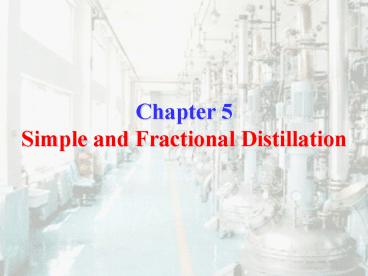Chapter 5 Simple and Fractional Distillation - PowerPoint PPT Presentation
Title:
Chapter 5 Simple and Fractional Distillation
Description:
Chapter 5 Simple and Fractional Distillation Distillation Distillation is used to separate two liquids of sufficiently different boiling points. – PowerPoint PPT presentation
Number of Views:127
Avg rating:3.0/5.0
Title: Chapter 5 Simple and Fractional Distillation
1
Chapter 5Simple and Fractional Distillation
2
Distillation
- Distillation is used to separate two liquids of
sufficiently different boiling points. - An equilibrium between vaporizing and condensing
in a distillation column allows for the
separation of liquids. - Most of the lower boiling liquid is collected in
a receiver vial while most of the higher boiling
liquid remains in the original flask. - The separation process is improved upon by
conducting subsequent re-distillations (simple
distillation, Fig. 5.5) or increasing column
surface area (fractional distillation, Fig. 5.7).
3
Simple Distillation
- 1. Add 60 mL of 20 ethanol-water mixture in a
100-mL round-bottomed flask from the macroscale
kit. - 2. Add boiling chips.
- 3. Assemble apparatus for simple distillation as
shown in Fig 5.10 (page 100). Ensure that all the
connections are tight. The bulb of the
thermometer should be below the opening into the
side arm of the distillation head. - 4. Heat the flask strongly on the thermo well (no
sand) until boiling begins, then adjust the heat
until the distillate drops at a regular rate of
one drop per second. - 5. Record both the temperature and volume of
distillate at regular intervals. Remember to
record the temperature at the first drop of
distillate and then after every milliliter that
you collect. - 6. After 50 mL of distillate is collected,
discontinue distillation and save your distillate
for fractional distillation. - 7. Working in the hood, place 3 drops of the
distillate using a Pasteur pipette on a Pyrex
watch glass and try to ignite it.
4
Fractional Distillation
- 1. Place the 50 mL of distillate from simple
distillation experiment back into the 100-mL
round-bottomed flask once it has cooled. - 2. Add boiling chips.
- 3. Assemble the apparatus for fractional
distillation as shown in Fig. 5.11 (page 102).
Use stainless steel wool that will be provided to
pack the fractionating column. - 4. Turn up the heat to the electric flask
gradually until the mixture just begins to boil.
Turn off the power and heat slowly as you watch
the ring of condensate rise gradually through the
column. This rise should be gradual so that the
column can acquire a uniform temperature
gradient. Make sure the ring has stopped rising
and then increase the heat gradually until
distillation starts. - 5. Insulate the column with a towel to prevent
flooding of the column as this slows down the
distillation. - 6. Record temperature for every milliliter of
distillate collected and take more frequent
readings as the temperature begins to rise
abruptly. - 7. Empty the contents of the graduated cylinder
into a 25 mL Erlenmeyer flask once it fills. - 8. Stop the distillation once the second constant
temperature is reached. - 9. Repeat the ignition test and note any
difference from before.































